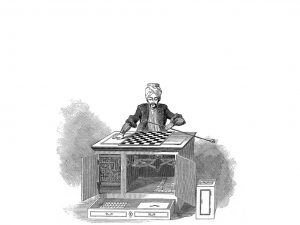Tom Standage in The Economist:
 In 1770 a chess-playing robot, built by a Hungarian inventor, caused a sensation across Europe. It took the form of a life-size wooden figure, dressed in Turkish clothing, seated behind a cabinet which had a chessboard on top. Its clockwork arm could reach out and move pieces on the board. The Mechanical Turk was capable of beating even the best players at chess. Built to amuse the empress Maria Theresa, its fame spread far beyond Vienna, and visitors to her court insisted on seeing it. The Turk toured Europe in the 1780s, prompting much speculation about how it worked, and whether a machine could really think: the Industrial Revolution was just getting started, and many people were questioning to what extent machines could replace people. Nobody ever quite guessed the Turk’s secret. But it eventually transpired that there was a human chess player cleverly concealed in its innards. The apparently intelligent machine depended on a person hidden inside.
In 1770 a chess-playing robot, built by a Hungarian inventor, caused a sensation across Europe. It took the form of a life-size wooden figure, dressed in Turkish clothing, seated behind a cabinet which had a chessboard on top. Its clockwork arm could reach out and move pieces on the board. The Mechanical Turk was capable of beating even the best players at chess. Built to amuse the empress Maria Theresa, its fame spread far beyond Vienna, and visitors to her court insisted on seeing it. The Turk toured Europe in the 1780s, prompting much speculation about how it worked, and whether a machine could really think: the Industrial Revolution was just getting started, and many people were questioning to what extent machines could replace people. Nobody ever quite guessed the Turk’s secret. But it eventually transpired that there was a human chess player cleverly concealed in its innards. The apparently intelligent machine depended on a person hidden inside.
It turns out that something very similar is happening today. Just like the Turk, modern artificial-intelligence (AI) systems rely on help from unseen humans. Training a “deep learning” system involves showing it millions of examples of an input (such as photographs of animals) and telling it what the correct output is (“cat”, “dog”) in each case. Once trained, the system can then correctly identify animals in pictures it has not seen before. But the training process requires huge numbers of correctly labelled examples – and those must be created by humans.
More here.
